We used standard mark-recapture techniques to investigate ecological characteristics of populations of Peromyscus leucopus (white-footed deermice) inhabiting two locations within a site contaminated by heavy metals, Tar Creek Superfund Site, and reference sites, Lake Carl Blackwell and Oologah Wildlife Management Area, in northeastern Oklahoma. Basic demographic parameters such as size of population, rate of survival, rate of recapture, mean minimum longevity, number of reproductively active females, reproductive success, and incidence of infestation by botflies (Cuterebra fontinella) were not significantly different between contaminated and reference sites. However, adult, non-reproductive P. leucopus inhabiting contaminated sites had, on average, a larger body mass than those from reference sites. Other indicators of overall individual health, dental condition and prevalence of botfly infestations were significantly different among populations. Instances of extensive mottling of the upper and lower incisors, a reliable indicator of exposure to contamination by heavy metals, were only noted in individuals inhabiting contaminated sites. Unfortunately, no direct link between contamination and alterations to some population parameters could be established.
How to translate text using browser tools
1 September 2010
Population Parameters of Peromyscus leucopus (White-Footed Deermice) Inhabiting a Heavy Metal Contaminated Superfund Site
Kendra L. Phelps,
Karen McBee
ACCESS THE FULL ARTICLE

The Southwestern Naturalist
Vol. 55 • No. 3
September 2010
Vol. 55 • No. 3
September 2010




